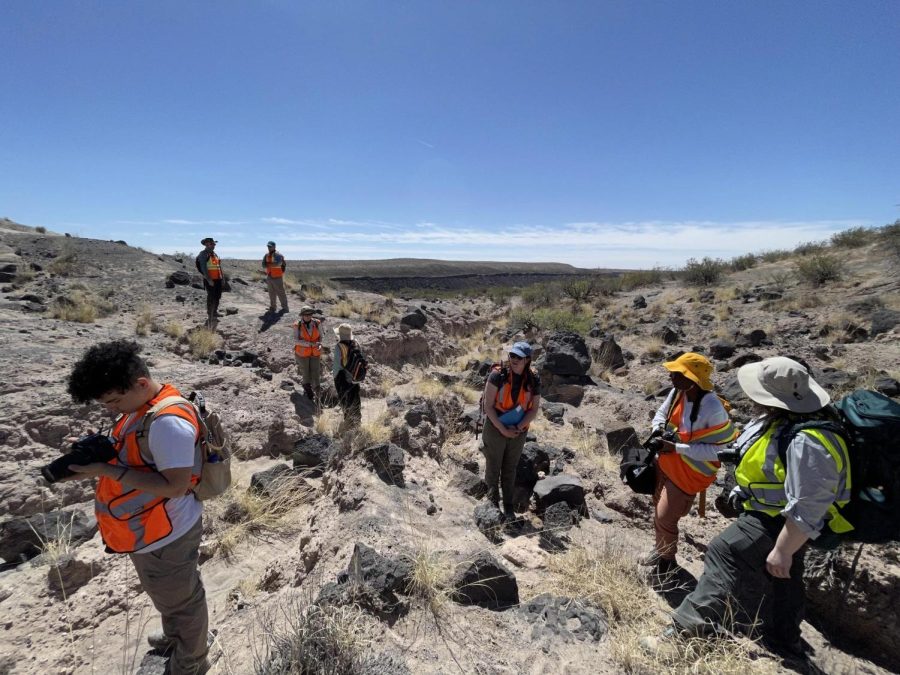SBU students gather with NASA scientists to explore an analog site on Earth for travel to the Moon.
“Analog sites” on Earth provide NASA with test runs for beyond our planet
March 20, 2023
It just feels like we are on another planet.
That was the consensus among the arriving students at Kilbourne Hole, New Mexico. On a swelteringly hot day in the middle of the desert, seemingly undisturbed by human settlement, one would not be alone in mistaking it for the famous desert planets of Tatooine from Star Wars or Arrakis from Dune.
All that means is that NASA and the RISE2 team did their jobs right.
Kilbourne Hole is just one of many “planetary analog sites”, or sites that are considered geographically, astro-biologically or compositionally similar to other known planetary bodies in our solar system and beyond. NASA and the RISE2 team utilize Kilbourne Hole and other sites across the planet to conduct research and tests that will inform the next generation of extraterrestrial exploration.
With NASA’s renewed focus being on placing humans on the Moon again in 2025, and the ultimate goal being a sustainable moon colony a few years after that, the RISE2 team has returned to Kilbourne Hole (and its sister site, Hunt’s Hole, to the south) to provide analog data for potential Moon-like scenarios.
“If you were to imagine an impact crater on the Moon, it would eject lots of different materials out into the surface,” NASA scientist Stephen Scheidt said about Kilbourne Hole while taking unmanned aerial vehicle data of the site with his drone. “The crater here is quite similar [to the Moon] in that respect.”
The site has an extensive history as an analog site for the Moon, dating back to January 1971 when the crew of Apollo 15 trained there to collect volcanic samples ahead of their mission to the Moon just six months later from July to August of that same year.
Much of the work being done today is similar to that conducted by the Apollo 15 team: simulated extravehicular activities, or EVAs, which are research missions that astronauts on the Moon or Mars or any planetary body would conduct while on their mission. These simulated missions at Kilbourne range from topographic surveys of the surface, to geological comparisons of the differing rock formations and compositions that layer the surrounding area, to general feedback from the “astronauts” on what data proved to be most useful in determining information about the “new planet” they had arrived on.
“With this location being volcanic, and for other locations in the solar system, we are interested to see if we can find and recognize samples that are also volcanic on other planets,” Dr. Scheidt stated.
With this location being volcanic, and for other locations in the solar system, we are interested to see if we can find and recognize samples that are also volcanic on other planets.
— Stephen Scheidt
According to NASA, there are a variety of different planetary analog sites across the world that serve various purposes. Researchers have spent time in the Chilean Atacama desert, which has served as a planetary analog for Mars, to which NASA has plans to send humans after more extensive work on the Moon has been accomplished within the next few years.
“Ground truth science on Earth provides valuable information about our home planet,” the agency said. “It also helps us to check our understanding of satellite imagery. When long-distance observations of Earth match with data gathered on the ground, we can be confident about using remote sensing on other worlds, too.”
Others attempting to simulate the conditions of Jupiter’s ice moon of Europa, whose liquid oceans beneath the ice have led scientists to believe that it is the most likely place in our solar system to have the conditions necessary to sustain life outside of Earth, have spent time living upon ice sheets in Greenland to better prepare for what might be encountered in a future crewed mission. Some researchers have even studied the harshest underwater volcanic environments like the Lō`ihi seamount in Hawaii to better understand how life might survive on the other planetary bodies in our solar system and possibly beyond.
Thus, as NASA continues its rapid approach towards returning to extraplanetary missions with humans again, these analog sites right here on Earth continue to provide the first steps towards preparing humans for life across the cosmos.
NASA said, “analog studies have already changed the way we understand our place in space, and there are many discoveries left to make. Future scientists, engineers, and astronauts will have exciting questions to answer. To succeed, they’ll need to learn all they can from each other and our home planet.”
Analog studies have already changed the way we understand our place in space, and there are many discoveries left to make. Future scientists, engineers, and astronauts will have exciting questions to answer. To succeed, they’ll need to learn all they can from each other and our home planet.
— NASA
